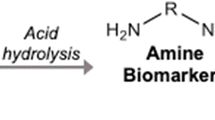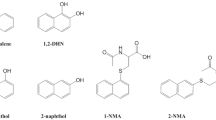Abstract
Objectives
To study the range of urinary levels of 4,4′-methylenedianiline (MDA), a metabolite of methylenediphenyl diisocyanate (MDI), across factories in the polyurethane industries and to evaluate the validity of this biomarker to assess MDI occupational exposure.
Methods
Workers exposed to MDI, as well as non-occupationally exposed subjects, were studied and pre- and post-shift urine samples were collected from 169 workers of 19 French factories and 120 controls. Details on work activities and practices were collected by a questionnaire and workers were classified into three job categories. The identification and quantification of the total urinary MDA were performed by high-performance liquid chromatography with electrochemical detection (HPLC/EC).
Results
For all the factories, MDA was detectable in 73% of the post-shift urine samples. These post-shift values, in the range of <0.10 (detection limit)–23.60 μg/l, were significantly higher than those of the pre-shift samples. Urinary MDA levels in the control group were in the range of < 0.10–0.80 μg/l. The degree of automation of the mixing operation (polyols and MDI) appears as a determinant in the extent of exposure levels. The highest amounts of MDA in urine were found in the spraying or hot processes. The excretion levels of the workers directly exposed to the hardener containing the MDI monomer were significantly higher than those of the other workers. In addition, skin exposure to MDI monomer or to polyurethane resin during the curing step were always associated with significant MDA levels in urine.
Conclusions
Total MDA in post-shift urine samples is a reliable biomarker to assess occupational exposure to MDI in various industrial applications and to help factories to improve their manufacturing processes and working practices. A biological guiding value not exceeding 7 μg/l (5 μg/g creatinine) could be proposed in France.

Similar content being viewed by others
References
ACGIH (2005) TLVs and BEIs. Threshold limit values for chemical substances and physical agents. American Conference of Governmental Industrial Hygienists, Cincinnati, OH
Allport DC, Gilbert DS, Outterside SM (2003) MDI and TDI: safety, health and the environment. A Source Book and Practical Guide. Wiley, England
Ameille J, Pauli G, Calestreng–Crinquand A, Vervloet D, Iwatsubo Y, Popin E, et al (2003) The corresponding members of the ONAP—reported incidence of occupational asthma in France, 1996–99: the ONAP programme. Occup Environ Med 60:136–141
API (2002) MDI/polymeric MDI emissions reporting guidelines for the polyurethane industry. Alliance Polyurethanes Ind 4:15–16
Bernstein DI, Korbee L, Stauder T, Bernstein JA, Scinto J, Herd Z, Bernstein IL (1993) The low prevalence of occupational asthma and antibody-dependent sensitisation to diphenylmethane diisocyanate in a plant engineered for minimal exposure to isocyanates. J Allergy Clin Immuno 92(3):378–396
Bilan RA, Haflidson WO, McVittie DJ (1989) Assessment of isocyanate exposure during the spray application of polyurethane foam. Am Ind Hyg Assoc J 50:303–306
Brunmark P, Persson P, Skarping G (1992) Determination of 4,4′–methylenedianiline in hydrolysed human urine by micro liquid chromatography with ultraviolet detection. J Chromatogr Biomed Appl 579:350–354
Brunmark P, Bruze M, Skerfving S, Skarping G (1995) Biomonitoring of 4,4′–methylene dianiline by measurement in hydrolysed urine and plasma after epicutaneous exposure in humans. Int Arch Occup Environ Health 67(2):95–100
Carino M, Aliani M, Licitra C, Sarno N, Ioli F (1997) Death due to asthma at workplace in a diphenylmethane diisocyanate-sensitized subject. Respiration 64:111–113
Castillon K (2000) OSHA Compliance issues: overexposure to methylene bisphenyl isocyanate (MDI) in a motor vehicles parts manufacturing facility. Appl Occup Environ Hyg 15(3):251–252
Chester DA, Hanna EA, Pickelman BG, Rosenman KD (2005) Asthma death after spraying polyurethane truck bedliner. Am J Ind Med 48:78–84
Crespo J, Galan J (1999) Exposure to MDI during the process of insulating buildings with sprayed polyurethane foam. Ann Occup Hyg 43:415–419
Dalene M, Skarping G, Lind P (1997) Workers exposed to thermal degradation products of TDI and MDI-based polyurethane: biomonitoring of 2,4-TDA, 2,6-TDA, and 4,4′-MDA in hydrolysed urine and plasma. Am Ind Hyg Assoc J 58:587–591
Deutsche Forschungsgemeinschaft, List of MAK and BAT Values (2005) Commission for the investigation of health hazards of chemical compounds in the work area. Report No 34. Wiley, Weinheim
European Chemicals Bureau (ECB) (2003) Risk assessment final draft: methylenediphenyl diisocyanate 28 July. OBE Rapporteur: Mr R Moreau, General Director, Service of Risk Management, R.A.C. Vesalius, Pachecolaan 19 box 5, B-1010 Brussels, Belgium
EEC (1993) directive 93/72/EEC: 19th adaptation of technical progress of council directive 67/548/EEC of 16 August 1967. Off J Eur commun L 258/29 Brussels
EPA (1998) Toxicological review of methylene diphenyl diisocyanate (MDI) (CAS No 101-68-8 and 9016-87-9) in support of summary information on the integrated risk information system (IRIS). US Environmental Protection Agency, Washington, DC
Hext PM, Booth K, Dharmarajan V, Karoly WJ, Parekh PP, Spence M (2003) A comparison of the sampling efficiencies of a range of atmosphere samplers when collecting polymeric diphenylmethane di-isocyanate (MDI) aerosols. Appl Occup Environ Hygiene 18:346–357
Hornung RW, Reed LD (1990) Estimation of average concentration in the presence of non detectable values. Appl Occup Environ Hyg 5:46–51
Käfferlein HU, Göen T, Müller J, Wrbitzky R, Angerer J (2000) Biological monitoring of workers exposed to N,N-dimethylformamide in the synthetic fibre industry. Int Arch Occup Environ Health 73:113–120
Kääriä K, Hirvonen A, Norppa H, Piirilä P, Vainio H, Rosenberg C (2001) Exposure to 4,4′-methylenediphenyl diisocyanate (MDI) during moulding of rigid polyurethane foam: determination of airborne MDI and urinary 4,4′-methylenedianiline (MDA). Analyst 126:476–479
Kimber I, Bernstein IL, Karol MH, Robinson MK, Sarlo K, Selgrade MK (1996) Identification of respiratory allergens: workshop overwiew. Fund Appl Toxicol 33:1–10
Lewalter J, Steinmann-Steiner-Haldenstält W (1994) Verhanlungen der Deutschen Gesellschaft Sonderdruck aus den Verhanlungen de Deutschen Gesellschaft für Arbeitsmedizin und Umweltmedizin. Gentner Verlag, Stuttgart, pp329–334
Littorin M, Rylander L, Skarping G, Dalene M, Welinder H, Strömberg U, Skerfving S (2000) Exposure biomarmers and risk from gluing and heating of polyurethane: a cross sectional study of respiratory symptoms. Occup Environ Med 57:396–405
Lofgren DJ, Walley TL, Peters PM, Weis ML (2003) MDI exposure for spray-on truck bed lining. Appl Occup Environ 18:772–779
Maître A, Stoklov M (1997) La biométrologie: cas de l’exposition aux isocyanates. Journées médicales du CISME, Paris
Maître A, Perdrix A (2004) Isocyanates. EMC-Toxicol Pathol 1(4):186–193
Marand A, Karlsson D, Dalene M, Skarping G (2004) Determination of amines as pentafluoropropionic acid anhydride derivatives in biological samples using liquid chromatography and tandem mass spectrometry. Analyst 129:522–528
McAlinder J (1999) Isocyanates in working life, international workshop organised by the Swedish National Institute for Working Life (NIWL): isocyanates-measurement methodology, exposure and effects. April 26–28, Brussels
Meuling WJA, Bragt PC, Leenhers LH, de Kort WLAM (1991) Dose-excretion study with the insecticide propoxur in volunters. In: Scott RC, Guy RH, Hadgraft J, Boddé HE (eds) Prediction of percutaneous penetration, methods, measurements and modelling, vol 2, pp13–19
Perkins JL, Cutter CN, Cleveland MS (1990) Estimating the mean, variance and confidence limits from censored (<limit of detection), lognormally distributed exposure data. Am Ind Hyg Assoc J 51:416–419
Peterson JC, Estiva EC, Lyttle DS, Harris RM (1991) High performance liquid chromatographic determination of 4,4′–methylenedianiline in human urine. J Chromatogr Biomed Appl 564:205–212
Rattray NJ, Botham PA, Hext PM, Woodcock DR, Fielding I, Dearman RJ, Kimber I (1994) Induction of respiratory hypersensitivity to diphenylmethane-4,4′-diisocyanate (MDI) in guinea pigs. Influence of route of exposure. Toxicology 88:15–30
Robert A, Ducos P, Francin JM (1995) Determination of urinary 4,4′–methylenedianiline and its acetylated metabolites by solid-phase extraction and HPLC analysis with UV and electrochemical detection. Int Arch Occup Environ Health 68:44–51
Romazini S (1993) Fonction respiratoire et symptômes des sujets exposés aux diisocyanates. Thèse de doctorat en médecine, Université joseph Fourier, Faculté de Médecine de Grenoble
Rosenberg C, Nikkilä K, Henriks-Eckerman MJ, Peltonen K, Engström K (2002) Biological monitoring of aromatic diisocyanates in workers exposed to thermal degradation products of polyurethanes. J Environ Monit 4:711–716
Sennbro CJ, Lindh CH, Östin A, Welinder H, Jönsson Bo AG, Tinnenberg H (2003) A survey of airborne isocyanate exposure in 13 Swedish polyurethane industries. Ann Occup Hyg 48(5):405–414
Sepai O, Henschler D, Sabbioni G (1995) Short–communication: albumin adducts, haemoglobin adducts and urinary metabolites in workers exposed to 4,4′-methylenediphenyl diisocyanate. Carcinogenis 16:2583–2587
Schütze D, Sepai O, Lewalter J, Miksche L, Henschler D, Sabbioni G (1995) Biomonitoring of workers exposed to 4,4′-methylenedianiline or 4,4′-methylenediphenyl diisocyanate. Carcinogenesis 16(3):573–582
Skarping G, Dalene M, Brunmark (1994) Liquid chromatography and mass spectrometry determination of aromatic amines in hydrolysed urine from workers exposed to thermal degradation products of polyurethane. Chromatographia 39(9–10):619–623
Skarping G, Dalene M (1995) Determination of 4,4′-methylenedianiline (MDA) and identification of isomers in technical–grade MDA in hydrolysed plasma and urine from workers exposed to methylene diphenyl diisocyanate by gas chromatography–mass spectrometry. J Chromatogr 663: 209–216
Skarping G, Dalene M, Littorin M (1995) 4,4′-Methylenedianiline in hydrolysed serum and urine from a worker exposed to thermal degradation products of methylene diphenyl diisocyanate elastomers. Int Arch Occup Environ Health 67(2):73–77
Skarping G, Dalene M, Svensson B-G, Littorin M, Äkesson B, Welinder H, Skerfving S (1996) Biomarkers of exposure, antibodies, and respiratory symptoms in workers heating polyurethane glue. Occup Environ Med 53:180–187
Vainio H, Rosenberg C, Hirvonen A, Norppa H (1999) International workshop on biomarkers for isocyanates—meeting reports. Scand J Work Environ Health 25(2):157–159
Vandenplas O, Malo JL, Dugas M, Cartier A, Desjardin A, Lévesque J, Shaughnessy MA, Grammer LC (1993) Hypersensitivity pneumonitis-like reaction among workers exposed to diphenylmethane diisocyanate (MDI). Am Rev Respir Dis 147(2):338–346
Wilson HK (1999) Biological monitoring values for occupational exposure: a United Kingdom perspective. Int Arch Occup Environ Health 72:274–278
Acknowledgments
The authors thank all those who took part in this study and most importantly the workers and managements for their cooperation, the occupational medicine and particularly Florence Lauzier, the regional health insurance funds (CRAMs) for their skilful medical and technical assistance, Clothilde Hecht and Anne-Marie Lambert-Xolin for analysing MDI monomer in the bulk samples and urinary creatinine.
Author information
Authors and Affiliations
Corresponding author
Rights and permissions
About this article
Cite this article
Robert, A., Ducos, P., Francin, J.M. et al. Biological monitoring of workers exposed to 4,4′-methylenediphenyl diisocyanate (MDI) in 19 French polyurethane industries. Int Arch Occup Environ Health 80, 412–422 (2007). https://doi.org/10.1007/s00420-006-0150-3
Received:
Accepted:
Published:
Issue Date:
DOI: https://doi.org/10.1007/s00420-006-0150-3




